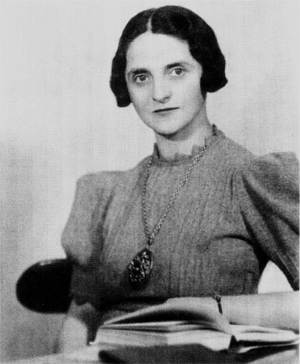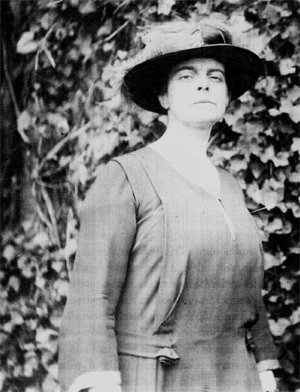Part 2 of 2
Upon Hanfstaengl's triumphant return to Germany, Hitler bestowed on him the honor of opening the sixth convention of the Nazi party at Nuremberg in September 1934. As the Fuehrer made his entrance amid the throngs that cheered him as the "Savior of Germany," Hanfstaengl praised the adoption by the Third Reich of the doctrine of the "purity of the race." [67]
President Conant later that fall refused the Nazi official's offer to the university of a $1,000 scholarship to permit a Harvard student to study in Germany for a year, including six months in Munich. Conant explained that the Harvard Corporation was "unwilling to accept a gift from one who has been so closely associated with the leadership of a political party which has inflicted damage on the universities of Germany." [68] The Harvard Club of Berlin, whose secretary, a General Electric executive, was president of the American Chamber of Commerce in the German capital, passed a resolution protesting the rejection of Hanfstaengl's scholarship. The club fully endorsed Nazi higher education policy, which it claimed was part of a necessary "program of national sanitation." [69]
In Germany, the Nazi press noted that the Harvard Crimson had denounced the Corporation's decision, claiming it deprived students of
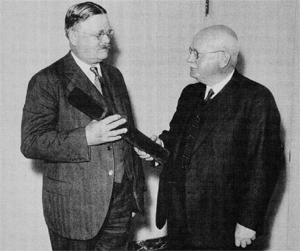 FIGURE 2.8. Dr. Hans Luther (right), Nazi Germany's ambassador to the United States, presents Roscoe Pound, dean of Harvard Law School, with an honorary degree from the University of Berlin, September 1934. Courtesy of the Boston Public Library, Print Department.
FIGURE 2.8. Dr. Hans Luther (right), Nazi Germany's ambassador to the United States, presents Roscoe Pound, dean of Harvard Law School, with an honorary degree from the University of Berlin, September 1934. Courtesy of the Boston Public Library, Print Department.the opportunity to study in "one of the greatest cultural centers of the world." The Nazis declared that the Crimson's dissent exposed a wide gulf between a promising postwar American student generation that resembled Hitler's young followers and a decadent faculty "still clinging to old-fashioned Wilsonism." [70]
Columnist Paul Mallon reported that feeling was widespread at Harvard that the university had turned down Hanfstaengl's offer because of the adverse public reaction to Harvard Law School dean Roscoe Pound's recent acceptance, in a public ceremony on campus, of an honorary degree from the University of Berlin, personally presented by Nazi Germany's ambassador Hans Luther. Luther and Nazi Germany's consul, Kurt von Tippelskirch, had hosted a luncheon for Dean Pound and members of the Law School faculty after the ceremony. [71]
Dean Pound was known to be sympathetic to Hitler, which President Conant acknowledged in a personal conversation with Felix Frankfurter, the lone Jew on the Harvard Law School faculty. [72] Pound spent part of his vacation in Nazi Germany during the summers of 1934, 1936, and 1937. In July 1934, he attended a full-day performance of the virulently antisemitic passion play at Oberammergau in Bavaria (described in Chapter 4), and pronounced it "wonderful." [73] Describing his impressions of Bavaria to the Paris Herald on August 4, 1934, Pound declared, "I never saw any indication of tension or fear of the future." He claimed that freedom of speech prevailed in the Third Reich: "People discussed Hitler and everything else openly, just as we talk of Roosevelt in the United States." [74] On his return to the United States, Pound expressed his admiration for Hitler in the New York Herald Tribune and claimed that in Nazi Germany "there was no persecution of Jewish scholars or of Jews ... who had lived in [Germany] for any length of time." [75]
When Felix Frankfurter learned that Ambassador Luther was to present Dean Pound with his degree at the Law School, he protested to President Conant that Harvard was tying "a tail to the Nazi kite" -- that is, lending its prestige to the Hitler regime. He did not ask Conant to forbid Pound from accepting the degree, but he did not want the ceremony held at Harvard. Conant replied that there was nothing he could do, and that, moreover, he "could not stay away" from the ceremony himself "without insulting a friendly government." Deeply disappointed, Frankfurter terminated the meeting after fifteen minutes and left. He noted in a personal memorandum about the encounter: "I abstained from pointing out to Conant that to exercise a veto power on Pound's personal right to accept the degree from Germany is one thing; to allow Langdell Hall [the Law School building] to be turned into a Nazi holiday quite another." [76]
Unlike Conant, Frankfurter refused invitations from both Dean Pound and Ambassador Luther to attend the ceremony. He wrote to Pound: "I cannot attend any function in honor of a representative of a government which Mr. Justice Holmes has accurately characterized as 'a challenge to civilization.''' Frankfurter declared that he could not "suppress my sense of humiliation that my beloved Law School, the centre of Anglo-American law, should confer special distinction upon an official representative of enthroned lawlessness." [77]
The Harvard administration's friendly reception of Hanfstaengl at the June commencement provided a rationale for Yale University president James Rowland Angell's decision to welcome a delegation of Italian Fascist students to his campus in October 1934. The Yale Daily News rushed to President Angell's support, justifying his decision by "cit[ing] President Conant's hospitality to Ernst F. S. Hanfstaengl last June." The Harvard Crimson ran a news story entitled "Yale Follows Harvard's Lead Greeting Italians." [78]
President Conant officially welcomed the Italian Fascist student delegation to Harvard several days before it visited Yale. The 350-student delegation, including about forty athletes, was touring American campuses on behalf of the Mussolini government to promote friendship between Italy and the United States. Conant greeted 160 of the Italian Fascist students at Harvard's University Hall, the administration building, on October 5, 1934, and in a brief address reviewed the history of Harvard. Harvard's president then shook the hand of each Italian Fascist student. The president of Harvard's Student Council, E. Francis Bowditch, and a group of Harvard undergraduates then led Mussolini's emissaries on a tour of the campus. The remaining members of the Italian student delegation, who spent the morning sightseeing in Boston, joined the 160 for lunch at seven of Harvard's undergraduate houses. [79]
During the afternoon, the Italian Fascist student athletes participated in a track meet at Harvard Stadium, competing against representatives of New England colleges, including Harvard, MIT, Brown, Holy Cross, Boston College, and Boston University. It was one of the largest track meets that had ever been held in the East. The track meet began with a parade of the entire Italian Fascist student delegation into the stadium, preceded by Italian trumpeters and accompanied by the Harvard band. When the delegation reached the center of the field, it sang the Fascist song. The Harvard Crimson praised Conant for welcoming the Italian Fascist students to the university and asserted that "[t]heir reception, tour of the buildings, and the track meet ... will be a step towards establishment of a close bond of friendship and understanding between the two nations." [80]
A few months later, in March 1935, the Harvard administration permitted Nazi Germany's consul in Boston, Baron von Tippelskirch, to place a wreath bearing the swastika emblem in the university's Memorial Church (Appleton Chapel). It was laid below a tablet Harvard had attached to the chapel wall "recognizing the heroism" and honoring the memory of four Harvard men killed in action fighting for Germany during the World War. The Boston Post declared that "for the first time since she received Ernst F. S. Hanfstaengl, Chancellor Hitler's right-hand man, at his class reunion last June did Harvard, by allowing the swastika to be displayed in her chapel, recognize and accept the new German Nazi state." It noted that the ceremony, which occurred on the day Germany annually commemorated its war dead, was attended by "a small group of prominent Harvard faculty members" and visiting professors from Nazi Germany. Some Harvard students protested against the placement of the "swastika wreath" on campus by an official representing a nation that "conducts hysterical racial massacres." But the Harvard Crimson supported the administration's commitment to what it called "Harvard's breadth of mind." [81]
On April 30, 1935, President Conant personally received Mussolini's ambassador to the United States, Augusto Rosso, and his consul general in Boston, Ermanne Armao, at his office at Harvard. President Conant's secretary, Harper Woodward, then escorted the Fascist diplomats on a tour of Widener Library, the Memorial Chapel, the Indoor Athletic Building, and Lowell House. [82]
Although Conant turned down the Hanfstaengl scholarship, Harvard chose not to follow the example of Williams College, whose president, Tyler Dennett, terminated student exchanges with German universities in April 1936. About sixty students from Nazi Germany attended American colleges and universities each year, solicited by schools in this country, while many Americans studied in Nazi Germany. Hanfstaengl, in fact, noted in October 1935 that the enrollment of Harvard students at the University of Munich had greatly increased since Conant had turned down his scholarship offer. [83]
Harvard continued the student exchanges, even though the German official in charge of them publicly announced in April 1936 that his government sent its students abroad to serve as "political soldiers of the Reich." German youths studying at foreign universities were required to first receive special training in "the principles of National Socialism." They also had to present to the Reich Ministry of Education a certificate from a Nazi party functionary attesting to their enthusiasm for Nazism. The Hitler government regarded exchange students as "an important element in Germany's foreign propaganda." [84]
Stephen Duggan, director of the Institute of International Education, which encouraged American student exchanges with foreign universities, in late 1937 correctly predicted that "Harvard, Yale, Columbia, Princeton," and other American universities that provided fellowships for students from Nazi Germany would remain impervious to mounting calls to terminate them. Nor, he added, would "any of the fine women's colleges -- Barnard, Vassar, Bryn Mawr, Holyoke, Smith, Wellesley, and Radcliffe -- which have had German exchange students practically every year," agree to join a proposed boycott. Duggan noted that many of America's "ablest" students were anxious to study in Nazi Germany in order "to see a modern French Revolution in actual operation." [85]
Harvard contributed significantly to the Hitler regime's effort in 1936 to gain international respectability by accepting the University of Heidelberg's invitation to send a representative to the 550th anniversary ceremonies of Germany's oldest institution of higher learning. More than twenty other American colleges and universities participated in the Heidelberg ceremonies. By contrast, no British university was willing to send a representative.
The Nazis wanted to favorably influence foreign perceptions of Germany as they embarked on a major rearmament program and stepped up persecution of the Jews. Germany reinstituted military conscription in March 1935. Shortly before Berlin was swept by savage antisemitic rioting in July, the New York Times quoted Propaganda Minister Josef Goebbels declaring, "We do not want the Jew .... Certain classes of intellectuals have interposed that, after all, the Jew is also a human being. Well ... the flea is an animal, but it is not a very pleasant animal." In September, the Nazis implemented the Nuremberg race Jaws, which deprived Jews of citizenship. Hitler sent his troops into the demilitarized Rhineland in March 1936, undermining the postwar security arrangement that prevented a German invasion of the West. [86] The Nazis believed that by hosting scores of distinguished academic guests from the United States and other Western democracies at an elaborate, carefully controlled, four-day festival, they could greatly enhance the prestige of the Nazi university, and of the government itself, outside Germany.
In the months prior to the University of Heidelberg's anniversary commemoration, President Conant communicated several times with President Nicholas Murray Butler of Columbia and President James Rowland Angell of Yale, in order to more effectively deflect criticism of their universities' decision to send delegates to the Nazi festival. Each designated as its representative a professor or administrator who was traveling in Europe at the time of the celebration, standard practice when an American university accepted such an invitation from a European counterpart. [87] Harvard was represented by Dr. George D. Birkhoff, dean of the faculty of the College of Arts and Sciences and Perkins Professor of Mathematics. The University of Heidelberg did not invite Princeton University to participate. This was probably because the Nazis tied the independent Institute for Advanced Study, located in Princeton, New Jersey, to Princeton University. The Institute had provided a faculty position for the refugee physicist Albert Einstein, whom the Nazis fiercely detested. [88]
After taking power in January 1933, the Nazis had quickly tightened party control over all German universities and suppressed all academic freedom, which was widely reported in the American press. German university students were in the forefront of the movement to Nazify German higher education. The German professoriate actively promoted the Nazi project and made vital contributions to it. As historian Max Weinreich has noted, "German scholars from the beginning to the end of the Hitler era worked hand in glove with the murderers of the Jewish people." [89]
The public book burnings staged at universities across the Reich in May 1933 underscored faculty and student support for Nazi antisemitism and anti-intellectualism. Students campaigned to destroy scholarly works they deemed "un-German," including anything written by Jews. About 40,000 people gathered to watch the bonfire near the University of Berlin, in which more than 20,000 books were destroyed. A little more than a week later, the University of Heidelberg staged its book burning, following a torchlight procession in which Nazi storm troopers marched alongside the student dueling corps "in full regalia, booted and sword-belted." [90]
The Nazis swiftly expelled nearly all Jews from university faculty positions, at least 800 in all by the 1934-35 academic year. The Jews forced out of the professoriate included many scholars of international renown, like Albert Einstein, Richard Courant, Max Born, James Franck, and Ernst Cassirer. In April 1933, the German government also passed a law severely limiting the enrollment of Jewish students in universities. Those few who remained were required to carry a red card of "non-Aryanism," while so-called "German" students were issued a "white card of honor." Many German universities initiated severely discriminatory policies against Jews even before the Nazi government required them to do so. Less than three months after the Nazi takeover, for example, the University of Hamburg refused to admit Jews any longer. [91]
By 1936, when the Nazis scheduled the anniversary commemoration, they were in complete control of the University of Heidelberg. The rector, Wilhelm Groh, announced in the summer of 1935 that only professors committed to advancing the Nazi revolution in the universities belonged on the faculty, and that even those Christians who were married to Jews should be removed. Groh habitually wore a military uniform to academic functions. [92] Between 1933 and 1936, the University of Heidelberg discharged forty-four faculty members for "racial, religious, or political reasons." No other faculty there protested these dismissals. Heidelberg required that its students join Nazi party organizations and frequently attend speeches by Nazi officials. [93]
In an action of enormous political significance, the Nazis replaced the statue of Athena, Greek goddess of wisdom, over the entrance to Heidelberg's main classroom building with a large bronze eagle, which they intentionally pointed west toward France, their enemy. The university substituted a new inscription, "To the German Spirit," and a golden swastika in place of the old "To the Eternal Spirit." [94]
The German universities incorporated the Nazi outlook in their curricula, in the sciences as well as the arts. Reich minister of culture and education Bernhard Rust announced in January 1935 that Nazi race theory would constitute the foundation of all university studies. Max Weinreich noted that German scholarship of the mid-1930s "looks like a gigantic assembly line working toward one aim" -- the campaign against the Jews and preparation for war. [95] University anthropologists and biologists contributed significantly to the elaboration of a virulently antisemitic "racial science" that the Nazis introduced into school curricula. Law school professors similarly helped the Nazi state fashion and refine antisemitic legislation and provided justification for Nazi legal initiatives. They presented papers at a 1936 conference on "Jewry and Jurisprudence." Richard Evans notes that the University of Heidelberg's Social and Economic Sciences Faculty "focused its research on population, agricultural economics, and the vaguely named 'spatial research' which in fact was focused on accumulating knowledge relevant to the proposed future expansion of the Reich in the pursuit of 'living space.''' Because of the Nazis' exaltation of military force, German university students devoted about one-third of their time to paramilitary exercises and drill. [96]
In 1935, the University of Heidelberg became one of the two principal centers for the propagation of what the Nazis called "Aryan Physics," reflecting the sharp deterioration of educational standards under the Nazis. In December 1935, in a ceremony a trended by leading German academics and industrialists that concluded with the Horst Wessel song, the University of Heidelberg Physics Institute was renamed the Philipp-Lenard-Institut, after the school's best-known professor, a Nobel laureate and longtime Hitler supporter. Lenard's mission was to remove what he called "Jewish science" from physics. In the principal speech at the dedication, Dr. Wacker, substituting for Education Minister Rust, who was ill, declared that "[t]he Negro or the Jew will view the same world in a different way from the German investigator." [97]
The next day "an imposing number of German physicists" gathered at the Philipp-Lenard-Institut to declare their commitment to combating "Jewish evil." Professor Dr. Tirala, speaking on "Nordic Race and Science," attributed the principal scientific discoveries since ancient times to "Nordic" investigators. Professor Lenard concluded by declaring that "the Jew is strikingly lacking in appreciation of Truth" and urging those present to "continue energetically the fight against the Jewish spirit." [98]
In early 1936, Lenard published the first volume of his four-volume Deutsche Physik, printed in Gothic type to emphasize its "Germanness" (Deutschtum). [99] Lenard intended his work to serve as the principal text for university students on Aryan physics. In it, he asserted that "[s]cience ... is racial and conditioned by blood." [100] Heidelberg student leaders embraced Lenard's outlook. For example, in the German academic journal Deutsche Mathematik, Fritz Kubach, Reichsleader of the German Student Body in the Department of Mathematics, a national position, demanded that the "fundamental questions of Mathematics" be "handl[ed] ... on a racial basis," which required "the destruction of the ... influence of Jews" in the field. [101]
The leading members of the University of Heidelberg's medical faculty enthusiastically promoted what the Nazis called "racial hygiene," which involved sterilizing people they considered "defective." Professor Hans Runge supervised hundreds of forced sterilizations at the university's women's clinic. Heidelberg professor Carl Schneider became prominent in the Nazi government's "program to systematically murder the mentally ill and handicapped." [102]
All this notwithstanding, Harvard accepted the invitation to participate in the University of Heidelberg's anniversary celebration on March 2, 1936, several days after the leading British universities had publicly announced their refusal. The New York Times on February 28 reported that Britain's preeminent universities, Oxford and Cambridge, had refused to send delegates to Heidelberg because of that university's discharge of forty-four faculty members "on the grounds of race, religion, and politics" and its "suppression of academic freedom." They were joined by the Universities of Manchester, Liverpool, Birmingham, London, Edinburgh, and Dublin. The Times noted that the scheduling of the ceremony on the date of the 1934 Blood Purge had resulted in "widespread suspicion" in Britain that "the anniversary is intended not to honor Heidelberg, but to glorify the Nazi regime." Moreover, the prestigious British scientific journal Nature charged that evidence in the British Museum revealed that the University of Heidelberg's charter had been issued in October 1385 and its first session had begun in October 1386, and thus the upcoming anniversary was not the school's 550th. [103]
In late March, the eminent British medical historian Charles Singer urged President Conant to reconsider his decision to send a Harvard representative to Heidelberg. The University of London professor asserted that "the scandals at Heidelberg have been even above the normal level of German universities both in gravity and number," and that faculty and students at the school shared and often expressed Philipp Lenard's views. Singer informed Conant that leading universities in the Netherlands, including Leyden, Utrecht, and Groeningen, had joined the British universities in refusing to send delegates. [104]
Two Jewish Harvard alumni warned Conant that the German government intended to use the Heidelberg celebration as a vehicle for spreading Nazi propaganda, just as it had at the recently concluded fourth Winter Olympiad held in the twin Bavarian towns of Garmisch and Partenkirchen. [105] Westbrook Pegler, columnist for the New York World-Telegram, noted that the Winter Olympics had proven that "the Nazis could not be trusted to refrain from political and military propaganda" when sponsoring international gatherings. The New York Times reported that, during the Winter Olympics, Garmisch and Partenkirchen had "become a forest of ... swastika flags," with the Nazi symbol "waving from every roof and draped from almost every balcony," while the flags of other nations were seldom visible. Foreign journalists covering the Winter Olympiad were stunned when State Secretary Funk of the Propaganda Ministry opened the games with a long speech extolling Hitler and Nazism. [106]
Many American observers agreed with William L. Shirer, one of the most experienced foreign correspondents in Germany, that Hitler had scored a major propaganda triumph at Garmisch and Partenkirchen. Shirer reported that the lavish ceremonies, modeled on the Nuremberg rallies, made the Nazis appear administratively efficient. Foreigners had also been impressed with the well-mannered treatment accorded visitors, which to Shirer and other American journalists familiar with the Nazis "of course seemed staged." The New Republic commented that the Nazis "unquestionably considered the Games ... as demonstrating international approval of the present regime." [107]
G. E. Harriman, executive secretary of the Non-Sectarian Anti-Nazi League, stressed that the Germans had spread "tremendous Nazi propaganda" at two international scholarly conferences they had recently hosted -- the International Prison Congress in Berlin and the Congress for Health and Hygiene. Harriman reported that the foreign delegates attending these conferences had been "inundated with speeches by Nazi officials." In radio broadcasts throughout Germany and abroad, the Nazis had attempted to associate the prestige of "these gatherings of [distinguished] scientists" with the Hitler regime itself. [108]
Conant nevertheless remained steadfast in his commitment to have Harvard represented at Heidelberg, and he received strong support from the Harvard Crimson. In a press release announcing Harvard's acceptance of the Heidelberg invitation, Conant had declared that "the ancient ties by which the Universities of the world are united ... are independent of ... political conditions." He indicated that Harvard had already expressed "strong disapproval" of the "present [German] regime in respect to academic freedom" when it turned down the Hanfstaengl scholarship. [109] Those who wrote to challenge his decision received a standard reply from Conant's secretary insisting that Harvard's relationship with the University of Heidelberg was "purely academic," and that "the matter of politics should not enter." The Harvard Crimson similarly editorialized that "Heidelberg University is not the Nazi government" and even claimed that it had opposed Nazi policies. It condemned the British universities that had refused Heidelberg's invitation for "dragging politics in." [110]
Alvin Johnson, director of the New School for Social Research, branded Harvard's idea of an international community of scholars that included Nazi Germany a dangerous delusion. He explained that the Graduate Faculty over which he presided, composed of German exiles, had been established "as an expression ... that there is no free German university." [111]
Conant considered Harvard's attendance at the Heidelberg ceremony part of a reciprocal exchange with German universities, whose representatives he had invited to participate in the Harvard tercentenary celebration scheduled for September 1936 and to present papers at the tercentenary conference preceding it. Harvard also planned to award honorary degrees to ten academics from Nazi Germany. These included Werner Heisenberg, who later directed Germany's effort to develop an atomic bomb during World War II, and Friedrich Bergius, whose chemical research proved highly important to the Nazi war effort. [112] When Dr. Charles Singer wrote to express strong opposition to sending a delegate to Heidelberg, Conant replied that the logic of his position would require Harvard to ban from its tercentenary events "German scientists who ... have embraced Nazi policy but nevertheless have remained distinguished members of the world of scholars." Conant pronounced such a view "absurd." [113]
President Nicholas Murray Butler of Columbia aggressively defended Harvard's invitation to Nazi academics to its tercentenary, insisting that "academic relationships have no political implications." To the chairman of a Columbia student committee established to protest that university's decision to send a delegate to Heidelberg, Butler sneered, "Perhaps the Germans might reply that they would send no representatives to the Harvard Tercentenary Celebration next September because they do not approve of what the newspapers here call the New Deal." [114]
Albert Einstein took sharp issue with Conant's and Butler's insistence that academic celebrations had nothing to do with politics. He did not attend the Harvard tercentenary celebration, although invited, because he objected to participation by German academics who supported Nazi policies. [115]
As Conant was making plans for Harvard's participation at Heidelberg, he refused requests from Jewish alumni and the mayor and city council of Cambridge to reschedule the Harvard tercentenary celebration, which the administration had decided would take place on Rosh Hashonah. Protests concerning the date had first been presented to the Harvard administration in December 1934. The Cambridge city council resolution asking for a change of date, adopted on April 21, 1936, noted that many of Harvard's Jewish graduates, "from Justice Brandeis down the ladder of fame have added to the glory and prestige of Harvard." Conant claimed that the university was limited to only two dates in staging the tercentenary celebration -- November 8, equivalent to October 28 on the Julian calendar used in 1636, or September 18, equivalent to September 8. The former, which marked the passage of the act of the Massachusetts Bay Colony's General Court that established the college, fell on Sunday, the Christian day of worship, making it unacceptable to the administration. It therefore chose September 18. Taking issue with its Jewish critics, the administration saw nothing in the "dignified ceremonies" it planned that was "incompatible with the proper religious observance" of the Jewish New Year. [116]
Conant joined with Butler and President Angell of Yale in drafting a statement to be released if the Nazis at the Heidelberg ceremony publicly claimed that the presence of delegates from American universities represented an endorsement of the Nazi regime. The statement, mostly Butler's work, criticized the "German government's actions in regard to academic freedom." It praised a long list of men who had made significant contributions to German culture. Butler noted to Conant that he had deliberately included Spinoza, invited to Heidelberg in 1673; Heine; and Mendelssohn, all of whom the Nazis considered Jews. The statement, however, was never issued. The congratulatory greeting that Columbia sent to Heidelberg did not mention any of the latter's Jewish scholars, or even Christians of Jewish ancestry. [117]
The University of Heidelberg anniversary celebration, held from June 27 to June 30, 1936, was highlighted by fiery Nazi speeches delivered by top officials of the Hitler regime and a massive military display. Harvard was represented by Dr. George Birkhoff, dean of the faculty of the College of Arts and Sciences, a mathematics professor who held antisemitic views. At the ceremonies he was in the company of Nazi propaganda minister Josef Goebbels, a Heidelberg graduate, who delivered a welcoming address; Nazi racial theorist Alfred Rosenberg; Education Minister Rust; Ernst Hanfstaengl; and SS chief Heinrich Himmler. As the flags of the participating countries were hoisted in the opening ceremonies, the spectators gave the Nazi salute. A brown-shirted storm trooper was stationed at each flagpole. During the first two days, "military bands and goose stepping ... held the center of the stage," and no academic robes were visible. [118]
Following Protestant and Catholic religious services, on the second day, a Sunday, storm troopers drove the foreign guests to a military cemetery overlooking the city of Heidelberg for a memorial ceremony in honor of German soldiers killed during the World War. Presiding was Dr. Schmitthenner, professor of military science at Heidelberg, who proclaimed that Germany's dead had entered Valhalla. He declared that Germany had not been defeated in the World War, and that God had sent her "a great leader, Adolf Hitler, to ... liberate the nation." Columbia University's representative, Arthur F. J. Remy, Villard professor of Germanic philology, characterized the service at the war cemetery as "very impressive and dignified." [119]
The anniversary celebration climaxed on June 29 and 30 with lengthy speeches praising Nazi educational policy by Education Minister Rust and Heidelberg philosophy professor Dr. Ernst Krieck, who became rector the next year. Heidelberg presented honorary degrees to foreign professors, including two from Harvard, Kirsopp Lake and Reginald Aldworth Daly. Rust proclaimed that Germany had discarded forever "the old idea of science" as "abstract intellectual activity" and made scientific research conform to the Nazi outlook. He explained that German universities had removed Jews from their faculties because they belonged to an "alien race," which rendered them unable to understand the "order of nature." The next day Krieck similarly declared that science must be in accord "with the great racial and political task before us." [120]
Back in the United States, Conant remained adamant that Harvard had been "absolutely right" to send a representative. When President Angell wrote to report some alumni concern about the German press coverage, Conant refused to consider issuing the joint statement they had prepared with Butler. He declared, in fact, that the British universities would "live to regret the day when they broke diplomatic relations ... with one section of the learned world." Conant considered the harangues by Rust and Krieck "no more absurd than some statements about the aims of education" he had heard expressed in the United States. Conant decided, moreover, that because of the Harvard tercentenary, he would refrain during the next six weeks from making any criticisms of the Nazi regime "out of politeness and good manners." Harvard, after all, was "being host to delegates from German universities." [121]
Harvard's administration remained indifferent to calls to boycott the Olympic Games scheduled to take place in Berlin in late July and August 1936, shortly after the Heidelberg anniversary celebration. As host of such a prestigious international gathering, Nazi Germany presented itself as a respectable, and responsible, member of the world community. The Hitler regime planned to make the Olympics a spectacle that would highlight the vigor and prowess of "Aryan" youth, and Germans' enthusiasm for Nazism. In February 1936, Nazi Germany's Reichssportfuhrer (state commissar for sports), Dr. Hans von der Tschammer-Osten, approved publication of a handbook for German athletes that declared they must be "political fighters for Nazism." The German athlete should be fully conversant with Nazi principles and "above all ... will be expected to defend convincingly Hitler's racial legislation." The handbook "sternly cautioned" German athletes against the "dangers resulting from interracial breeding." [122] Neither President Conant nor his colleagues Presidents Angell of Yale and Butler of Columbia joined the small group of college and university presidents that endorsed a boycott, which included Presidents Tyler Dennett of Williams, Daniel Marsh of Boston University, and Mary E. Woolley of Mount Holyoke. [123]
The Harvard Athletic Association (HAA), in fact, encouraged alumni to support American participation in the Berlin games. When the HAA in September 1935 mailed the ticket applications to that fall's Harvard-Yale football game to 35,000 alumni, it included on the back an appeal for funds to help pay the expenses of American athletes competing in Berlin. William]. Bingham, Class of 1916, Harvard's director of athletics, accused those favoring a boycott to protest Nazi policies of violating "all codes of sportsmanship." He accepted the assurances of Avery Brundage, president of the American Olympic Committee, who had recently visited Nazi Germany, that there was no discrimination there against Jewish athletes. [124] Brundage, an antisemite and later member of the America First Committee, drew this conclusion in part from conversations with German "Jewish leaders," always conducted in cafes in the presence of Nazi "chaperones." [125] Incredibly, Bingham claimed that the Olympics were awarded to a city, not a country, and that the German government had nothing whatsoever to do with the management of the games. In fact, the Hitler government tightly controlled preparations for the Olympics. [126]
Like Bingham, the Harvard Crimson supported U.S. participation in the Berlin Olympics and called on American athletes to "suppress their personal feelings about the internal affairs of the host." It declared that "intelligent men with first-hand information believe that the Nazi Government has fulfilled [its] pledges" not to discriminate against Jewish athletes. [127] Contrary to Brundage's claims, however, Americans had reliable information that Nazi Germany was systematically discriminating against and persecuting Jewish athletes. [128]
The Yale Athletic Board, like its Harvard counterpart, raised funds for the American Olympic athletes competing in Berlin. It sponsored a swimming meet in the campus gymnasium for this purpose. President Angell, himself a member of the Yale Athletic Board, defended the use of Yale facilities to provide funds for participants in the Berlin Olympics. He declared that once the American Olympic Committee decided to send a team to Berlin, the issue was settled. Angell noted that both Harvard and Princeton "felt it expedient to contribute to the expenses of the American group" traveling to Nazi Germany. [129]
The Yale Daily News and Daily Princetonian editorial boards joined the Harvard Crimson in opposing the boycott of the Berlin Olympics. The Yale Daily News dismissed as "absurd" the call of Jeremiah Mahoney, president of the U.S. Amateur Athletic Union, that the United States withdraw from participation. The Daily News argued that it was not clear that Nazi Germany had discriminated against Jewish athletes, and, even if it had, it was "highly questionable whether that would be any concern of the participating nations." Moreover, the Yale editors asserted, boycotting the Olympics implied "that no intercourse of any kind with Germany should be tolerated, that scientists, artists, men of letters, as well as athletes, should have nothing to do with Nazidom." [130]
Princeton's student newspaper contemptuously dismissed what it called "the almost ridiculous protests of those favoring an Olympic boycott." The Daily Princetonian declared in an editorial that advocates of a boycott made any "true sportsman or true American righteously ashamed that the United States" included in its population individuals so "narrow and selfish." Their arguments against participation in the Berlin games were "as groundless as they are warped." Just as Presidents Conant, Angell, and Butler had claimed that Nazi policies should not influence relationships among academics, the Daily Princetonian editors insisted that "[a]thletics have nothing to do with politics or race." [131]
The Berlin Olympics represented a significant propaganda triumph for Nazi Germany, which used them to project an image of modernism and efficiency. Its athletes accumulated more points than those of the United States, Italy's more than France's, and Japan's more than Britain's. Many concluded from the point totals and the frenzied Nazi crowds in the stadium that the Fascist societies were more dynamic than the seemingly decadent Western democracies, and that they represented the "wave of the future." [132]
Believing that Nazi universities still remained part of the "learned world," President Conant in March 1937 again responded favorably to an invitation from the University of Goettingen to send a delegate to its bicentennial celebration, also scheduled for "Purge Day," June 30, 1937. Goettingen prior to 1933 had been arguably the world's most prestigious university in physics and mathematics, but the Nazi transformation of German higher education had severely damaged its reputation. Goettingen had driven out its Jewish professors under the racial ruling applicable to civil servants. They included several of the world's most eminent scientists, like Richard Courant, Nobel laureate James Franck, and future Nobel laureate Max Born, directors of three of Goettingen's four institutes for physics and mathematics. In late 1933, Franz Boas observed that "the destruction of mathematics in the University of Goettingen ... was accomplished without a protest" from its non-Jewish faculty. [133]
Speaking for Harvard, Conant's secretary, Stephen H. Stackpole, announced that the university planned to be represented at Goettingen for the same reason it had chosen to send a delegate to Heidelberg the previous year. He quoted Conant's June 18, 1936, statement to alumni that" [i]n my opinion it was never more urgent than at the present moment to emphasize the unity of the learned world." [134]
Harvard astronomy professor Harlow Shapley informed Conant that "never in the history of the world has the gutting and disgrace of a scientific school been made so obvious as in the wrecking of the Institute[ s] for Mathematical and Physical Sciences at Gottingen." Shapley at that moment was attempting to raise funds to provide for the support of "a brilliant young astrophysicist," Martin Schwarzschild, formerly of Goettingen and at that time exiled in Oslo. TheNazis had barred Schwarzschild from using Goettingen's observatory and library, even though he was the son of Germany's "greatest astrophysicist and astronomer in recent times," who had "loyally helped the Germans murder thousands of Americans during the Great War." [135]
By early April 1937, every English university had announced its refusal to send a delegate to Goettingen, except for Durham, whose chancellor, the Marquess of Londonderry, was considered Nazi Germany's greatest friend in British society. The New York Times reported that "Cambridge's refusal was almost a rebuke to Goettingen for having sent the invitation." [136]
Although Harvard's initial reaction to the invitation was favorable, not many American universities expressed interest in sending delegates. Among prestigious universities, only MIT announced it would be represented. Even there, many students fiercely protested their administration's decision. The MIT student newspaper, the Tech, bitterly denounced President Karl Compton's position, declaring that, "[i]n lending the name of a leading American scientific school to the Goettingen fete," MIT was "placing a feather in the cap of the educational gangsters ... who control the present German system of schooling." The Goettingen bicentennial was not "a scientific meeting" in which MIT sent "a group of professors to exchange technological information and ideas," but a "Nazi celebration." [137]
In early May I 9 37, President Conant and the Harvard Corporation decided to send greetings to the University of Goettingen instead of a delegate but planned to keep the press from learning that until June. The news was, however, quickly leaked to the Boston Globe, which reported it on May 5. Harvard's letter of greeting to Goettingen expressed "sincere sorrow" at not being able to send a delegate and conveyed "the most fraternal of feelings." The Dallas Morning News noted that the messages Yale and Princeton sent Goettingen declining their invitations "were much more strongly negative" than Harvard's. [138]
Although President Conant did send Goettingen a warm letter of greeting, Harvard's official alumni publication and the Harvard Crimson expressed regret that the university would not be represented at the bicentennial. The Harvard Alumni Bulletin in an editorial criticized the administration's decision as "too much like a breaking off of communications." True to form, the Crimson declared that the administration had been "downright discourteous" to Goettingen. [139]
Irritated by the Harvard Alumni Bulletin's criticism, Jerome D. Greene, secretary to the Harvard Corporation, insisted in a letter to its editor that the university's not sending a delegate to the Goettingen celebration in no way implied "unfriendliness or disapproval." He explained that the usual procedure when a foreign university staged such an event was to send greetings: "If they can be sent by the hand of a delegate, so much the better." But sending a representative often proved too expensive, and sometimes an appropriate delegate was not available. Greene noted that he was preparing only that week to send cordial greetings to a provincial university in Britain, accompanied by a statement regretting that Harvard was unable to send a delegate. He emphasized that many of the universities that Harvard had invited to its tercentenary events could not afford to be represented by a delegate and just sent "cordial greetings." Greene concluded: "It is annoying to have both the Crimson and the Bulletin ignore these facts and represent Harvard as having 'refused' to send a delegate" to Goettingen. [140]
Greene repeated to President Conant shortly afterward that it was "the height of absurdity" for the Crimson, the Bulletin, and the press to have interpreted "the mere fact that a delegate was not going" to the Goettingen celebration as a "refusal." He even noted that Conant's office had informed him that Business School dean Wallace Donham was to be Harvard's delegate to Goettingen, and then a day or two later the office notified him that Donham was unable to go. [141] Greene again emphasized that Harvard's failing to send a delegate to Goettingen should in no way be interpreted as an "insult": "If we sent a delegate to every institution that sends us an invitation for an anniversary ... we could keep several professors busy the whole year doing very little else." [142]
Representatives of seven American colleges and universities, most notably MIT, were present at the Goettingen bicentennial festivities, held in what the New York Times called "a thoroughly National Socialist atmosphere." At the opening ceremony, Goettingen students in Hitler Guard uniforms stood smartly at attention as the swastika was raised to the tune of the Nazi anthem, the Horst Wessel song. The town streets "rang with the tramp of marching Storm Troopers." Goettingen awarded honorary degrees to two American professors, including A. B. Faust, head of Cornell University's German Department, who gave the rector the Nazi salute. [143]
Germany's education minister, Bernhard Rust, wearing the brown uniform of a Nazi party district leader, delivered the two principal bicentennial addresses, both of them intensely antisemitic. In the first, he proclaimed that "the future of science was the principle of race." When he finished speaking, Goettingen's rector rose to exclaim, "We honor and strengthen ourselves in that we cry, 'Our Fuehrer Adolf Hitler, sieg heil!'" The assembled scholars answered him with three lusty "heils." Two days later, Minister Rust lectured the American representatives that commitment to personal liberty invariably led to "dictatorship of the masses," followed by an even worse dictatorship of the Jews. He denounced the Jews as "world wanderers who know no fatherland." [144]
From 1933 through 1937, as the Nazi menace steadily increased and as Germany's savage persecution of Jews was widely reported in the United States, President Conant's administration at Harvard was complicit in enhancing the prestige of the Hitler regime by seeking and maintaining friendly and respectful relations with Nazi universities and leaders. The Harvard administration refrained from supporting protests against fascism and sometimes suppressed them, as when it directed campus police to tear down anti-Nazi fliers posted during Hanfstaengl's visit to the university. Harvard student leaders, notably those associated with the Harvard Crimson, on occasion even surpassed the administration in their desire to foster amicable relations between the university and the Nazi regime. When President Conant -- who admitted that he "was neither an interventionist nor an isolationist" until well after Germany launched its Western offensive in 1940 -- urged U.S. material assistance for Britain, the Crimson strongly condemned him, and much of the student body opposed him. [145] Reporting on the waves of violent attacks on Jews that broke out in Berlin in July 1935, New York Times correspondent Frederick T. Birchall noted that "anti-Semitism in its worst form is in the saddle" in Germany, and that "there is nothing -- save, perhaps, some echo of world opinion -- to exercise the least check upon it." [146] It is truly shameful that the administrative, alumni, and student leaders of America's most prominent university, who were in a position to influence American opinion at a critical time, remained indifferent to Germany's terrorist campaign against the Jews and instead on many occasions assisted the Nazis in their efforts to gain acceptance in the West.
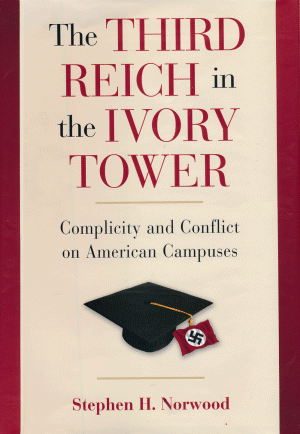
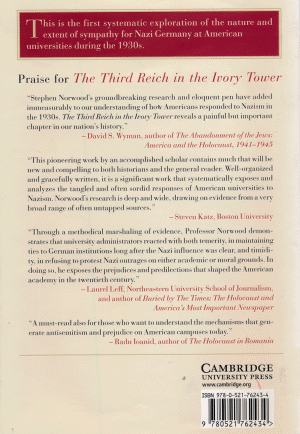
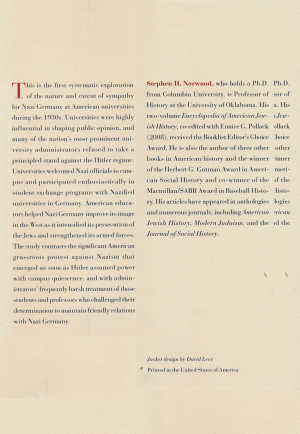

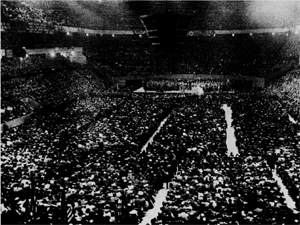
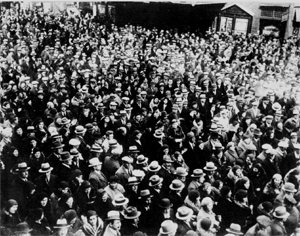
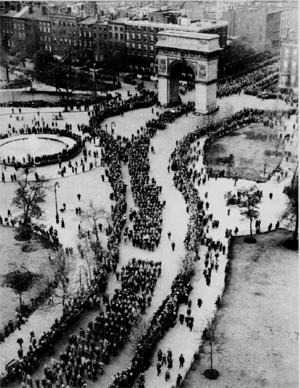
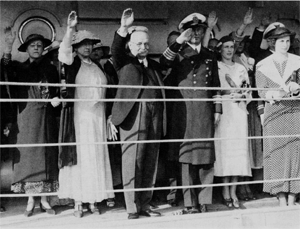
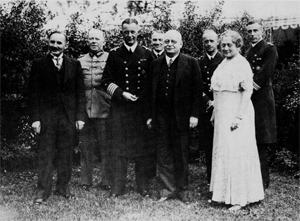
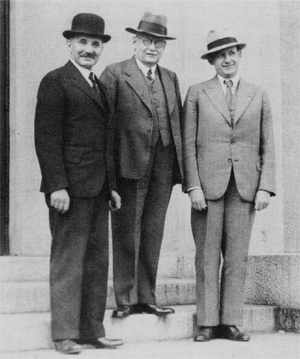
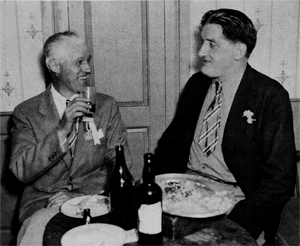
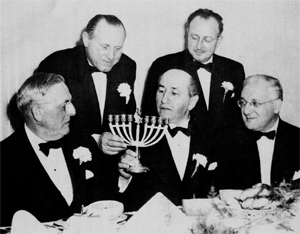
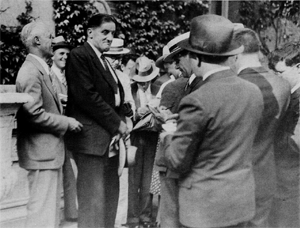
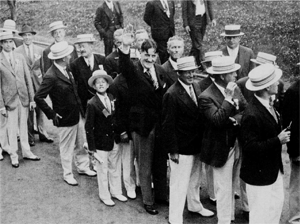

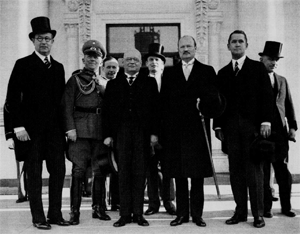
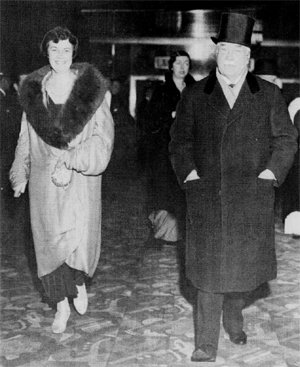 ]
]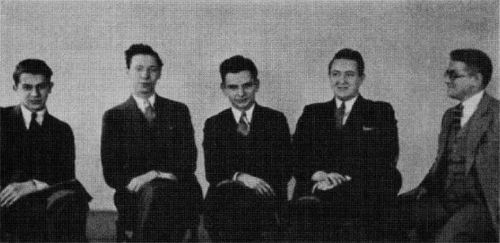 ]
]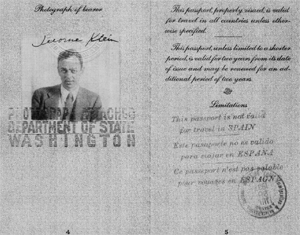 ]
]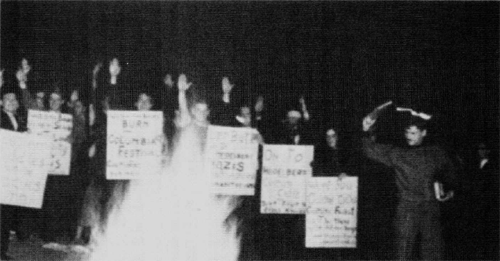 ]
]